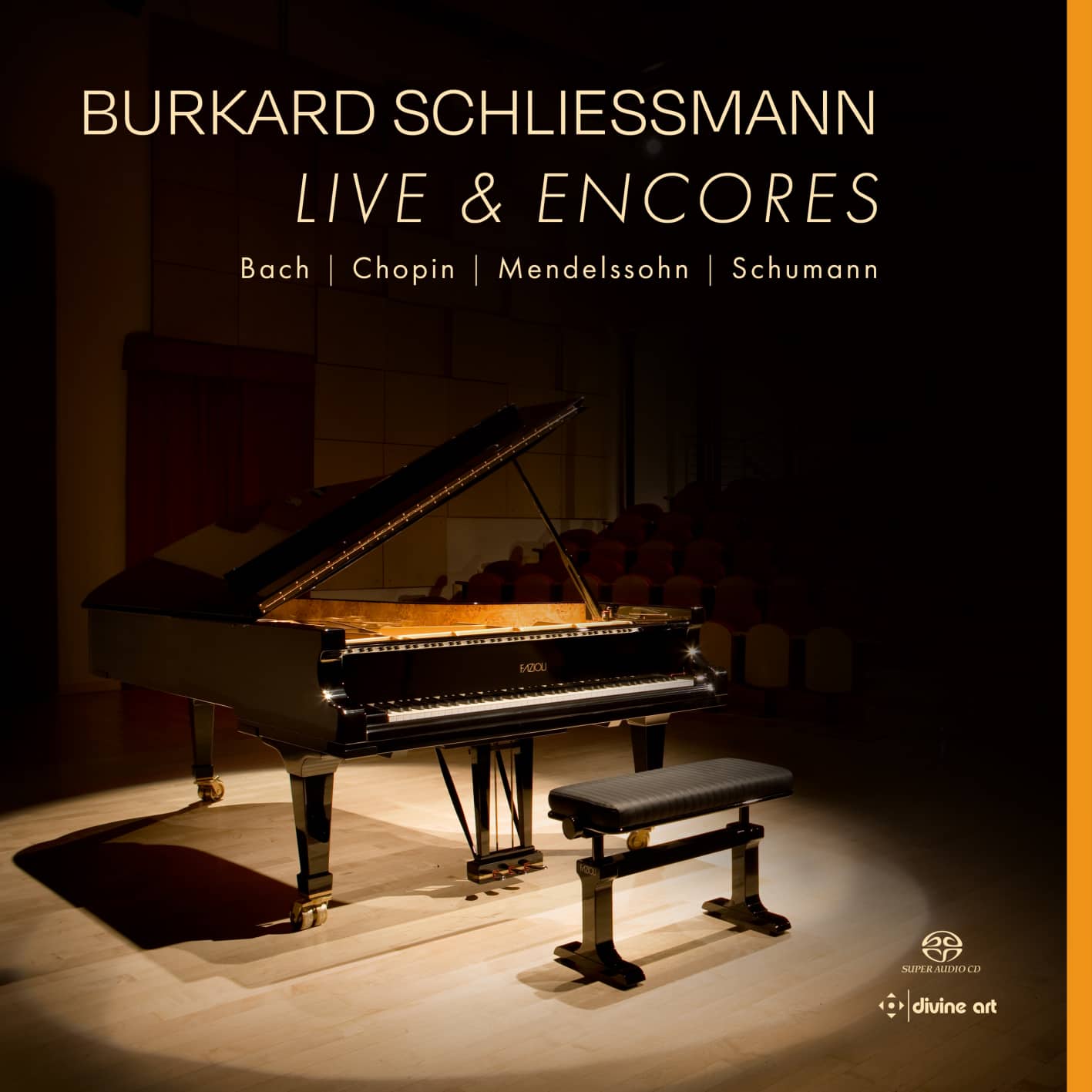Atlanta Audio Club
As I wrote of Burkard Schliessmann several years ago, “The native of Aschaffenburg Germany has often been noted for his passion for using all the resources of the instrument to get to the heart of the music and bring it out in all its expressive power and beauty…He is the last sort of pianist you would expect to just play the notes as written, without comment” (Phil’s Classical reviews, Jan, 2022). What I said then still goes, as the present album “Live & Encores,” a 2-CD compendium of previously and newly released performances, bears out.
Disc A opens with a generous selection of the best keyboard works of J. S. Bach, starting with Partita No. 2 in C Minor, BWV 826. Bach leads off in a big way with a Sinfonia (another word for “overture”) that is distinguished for its bold opening with measured cadences and a quick-paced middle section. It is followed in this suite of pieces in dance tempo by a florid Allemande, nicely accented and rather quick for a dignified formal dance. The Courante, briskly paced and articulated, opens with a zestful lift-off. Then comes a Sarabande, usually the slowest of dances but rendered here in a lively tempo and in well-contrasted sections (which is Bach’s innovation, by the way, not Schliessmann’s). The Rondeau, a lively French dance with notable foot-falls and flourishes, is taken by Schliessmann for all it is worth, and he renders the Capriccio with a terrific tempo that pushes its limits.
The Italian Concerto, BWV 971, begins with a movement that is an Allegro in all but name, and is well-decorated with trills. An Andante in the style of a deeply moving arioso with florid embellishments and a mood of gentle pathos lies at the heart of this work. With a basic tempo that is almost funereal in its affect, it sets the listener up for the stunning contrast provided by the sensational Presto, concluding one of the best keyboard works of J. S. Bach. Schliessmann’s performance shows he is well cognizant of its beauty.
The Chromatic Fantasy and Fugue in D Minor, BWV 903, another all-time Bach favorite, is well-chosen for the next spot in the program, opening with swirling figurations and a restlessly questing mood. The slower tempo Bach chooses for the main section is just right for creating a philosophical impression as the overall effect. The work concludes with the Fugue, characterized by a slow, quiet opening that gradually increases in purposeful momentum as it progresses. Schliessmann observes the nice, steady pulse Bach gives this movement, as well as overall tempi that are well chosen to allow for flourishes, and even drama, as he moves along.
The disc concludes with Felix Mendelssohn’s Variations sérieuses, Op. 54. “Serious” is right, as many of these short piano pieces are as terse as they are furious, and Schliessmann does them full justice. But with such markings as Agitato, Con fuoco, and Allegro vivace, they would seem more significant for the challenge they pose for the performer than any attraction they might have for the listener – aside from Variations 11, Cantabile, consisting of a simple melody with active accompaniment, and 14, a very poignant Adagio. Generally speaking, with the exception of some of his Songs without Words, Mendelssohn did not put his very best into his solo piano music as compared with other genres. (See his Violin Concerto, Symphonies 3-5, his Octet, the Hebrides Overture and the Midsummer Night’s Dream Music for a better impression of his genius if you are just getting acquainted with this composer.)
Disc B opens with Robert Schumann’s famed Fantasie in C Major, Op. 17, which is notable for the composer’s mastery in blending, contrasting, and superimposing timbres. Schliessmann takes all these issues in stride, making this an eminently satisfying account of one of the most difficult works in the repertoire. It is marked by its rhapsodic lyricism occasioned by trill structures, which are typically in downward motion, in the opening movement. This is succeeded by a march in the middle movement that culminates in sensational back-rhythms and syncopations that still have the power to astonish us today, and a finale whose harmonic structure conjures up the image of a star-filled night of which Schumann was doubtless thinking when he subtitled this movement “Crown of Stars.” The reader will note how the composer reversed the usual order of this slow movement, marked “thoroughly fantastic and sorrowfully laden” (Durchaus fantastisch und leidenschaftlich vorzutragen) and what then became the middle movement with its thumping fortes in the afore-mentioned march tempo.
Two choice Schumann encores follow, concluding the program. In “Chopin” from the well-loved Carnaval, Schliessmannmakes the most of its widely spaced chord structures, lending a distinct mood of aloneness, if not outright sadness. In “Warum?” (Why?) from Fantasiestücke, Op. 12, with its limpid, highly expressive harmonies that serve to justify the title, the rising intensity in the middle, followed by a return to the initial mood of resignation, is handled superbly by the present artist.
@divineartrecordingsgroup
A First Inversion Company
Registered Office:
176-178 Pontefract Road, Cudworth, Barnsley S72 8BE
+44 1226 596703
Fort Worth, TX 76110
+1.682.233.4978












